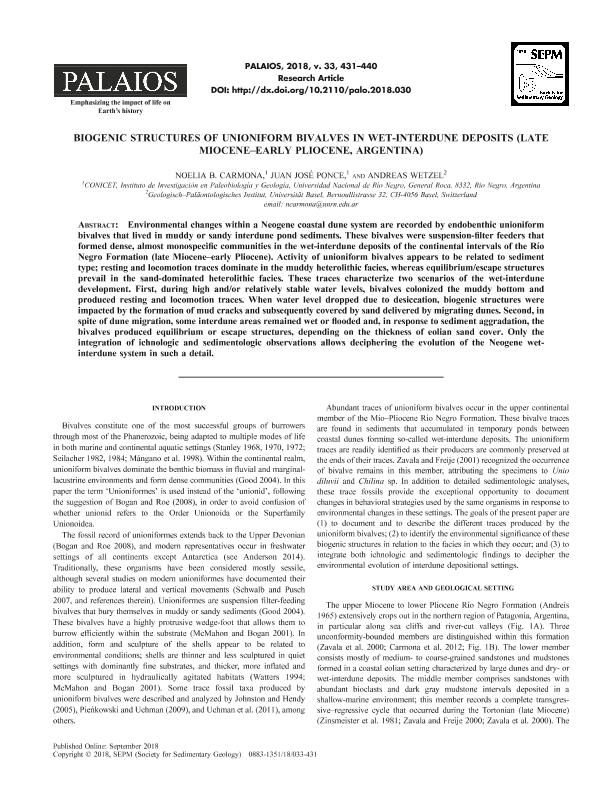Artículo
Biogenic structures of unioniform bivalves in wet-interdune deposits (Late Miocene-early Pliocene, Argentina)
Fecha de publicación:
09/2018
Editorial:
Society for Sedimentary Geology
Revista:
Palaios
ISSN:
0883-1351
Idioma:
Inglés
Tipo de recurso:
Artículo publicado
Clasificación temática:
Resumen
Environmental changes within a Neogene coastal dune system are recorded by endobenthic unioniform bivalves that lived in muddy or sandy interdune pond sediments. These bivalves were suspension-filter feeders that formed dense, almost monospecific communities in the wet-interdune deposits of the continental intervals of the Río Negro Formation (late Miocene-early Pliocene). Activity of unioniform bivalves appears to be related to sediment type; resting and locomotion traces dominate in the muddy heterolithic facies, whereas equilibrium/escape structures prevail in the sand-dominated heterolithic facies. These traces characterize two scenarios of the wet-interdune development. First, during high and/or relatively stable water levels, bivalves colonized the muddy bottom and produced resting and locomotion traces. When water level dropped due to desiccation, biogenic structures were impacted by the formation of mud cracks and subsequently covered by sand delivered by migrating dunes. Second, in spite of dune migration, some interdune areas remained wet or flooded and, in response to sediment aggradation, the bivalves produced equilibrium or escape structures, depending on the thickness of eolian sand cover. Only the integration of ichnologic and sedimentologic observations allows deciphering the evolution of the Neogene wet-interdune system in such a detail.
Palabras clave:
Río Negro Formation
,
Trace Fossil
,
Wet-Interdune
,
Eolian Dunes
Archivos asociados
Licencia
Identificadores
Colecciones
Articulos(IIPG)
Articulos de INSTITUTO DE INVESTIGACION EN PALEOBIOLOGIA Y GEOLOGIA
Articulos de INSTITUTO DE INVESTIGACION EN PALEOBIOLOGIA Y GEOLOGIA
Citación
Carmona, Noelia Beatriz; Ponce, Juan Jose; Wetzel, Andreas; Biogenic structures of unioniform bivalves in wet-interdune deposits (Late Miocene-early Pliocene, Argentina); Society for Sedimentary Geology; Palaios; 33; 9; 9-2018; 431-440
Compartir
Altmétricas




